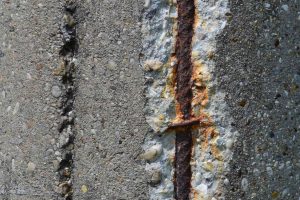 The corrosion of steel inside of concrete is the current leading cause of deterioration within concrete. As the steel corrodes, the volume of rust will be larger than the volume of the steel. This gradual expansion stresses the surrounding concrete, which will eventually lead to cracking, delamination, and spalling. Why does steel corrode in concrete and how can you detect it using GPR?
The corrosion of steel inside of concrete is the current leading cause of deterioration within concrete. As the steel corrodes, the volume of rust will be larger than the volume of the steel. This gradual expansion stresses the surrounding concrete, which will eventually lead to cracking, delamination, and spalling. Why does steel corrode in concrete and how can you detect it using GPR?
Why Does Steel Corrode in Concrete?
Steel is not a naturally occurring material, so it gradually corrodes over time. Unlike gold or platinum, steel is thermodynamically unstable. This means that it will gradually release the energy that was added to iron ore to produce steel over time and return to its original state—iron oxide or rust. The formal name of this is corrosion. Corrosion occurs when two metals or two pieces of metal are at different energy levels, there is an electrolyte, and there is a metallic connection between the parts. In concrete, the concrete itself acts as an electrolyte for the steel and wire ties, chair supports, or rebar serve as metallic connections between the metals.
How Can You Detect Corroded Steel with GPR?
GPR services use a central computer, received, and transmitter to transmit radio waves into the concrete that is being scanned. Radio waves enter the ground and bounce off whatever is underneath the surface and return back to the receiver. The central computer interprets radio signals as they return through the ground and provides a three-dimensional picture of what lies beneath the surface. GPR services can be used to detect a wide range of abnormalities beneath the surface, including corroded steel within concrete.
Corroded rebar or steel will scatter the GPR signal because it is not a solid piece of metal. While some people will simply brush off these results, at Concrete Visions we understand how to interpret complicated or scattered GPR results and determine if further tests are needed to detect corroded steel within concrete.
Choose Concrete Visions for Your GPR Needs
Concrete Visions has over 12 years of experience and expertise in concrete scanning and we know how to detect any problems lurking beneath the surface. We use ground penetrating radar accurately and expertly and are familiar in many other methods that can be used when appropriate like concrete x-ray and electromagnetic conductivity. If you would like to learn more about how we can help you, give is a call at (410) 766-2210 or visit us online. For more articles and tips, follow us on Facebook, Twitter, LinkedIn, and Google+.
